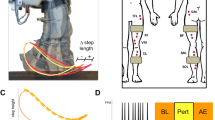Abstract
In the framework of the equilibrium-point hypothesis, virtual trajectories and joint stiffness patterns have been reconstructed during two motor tasks practiced against a constant bias torque. One task required a voluntary increase in joint stiffness while preserving the original joint position. The other task involved fast elbow flexions over 36°. Joint stiffness gradually subsided after the termination of fast movements. In both tasks, the external torque could slowly and unexpectedly change. The subjects were required not to change their motor commands if the torque changed, i.e. “to do the same no matter what the motor did”. In both tasks, changes in joint stiffness were accompanied by unchanged virtual trajectories that were also independent of the absolute value of the bias torque. By contrast, the intercept of the joint compliant characteristic with the angle axis,r(t)-function, has demonstrated a clear dependence upon both the level of coactivation and external load. We assume that a template virtual trajectory is generated at a certain level of the motor hierarchy and is later scaled taking into account some commonly changing dynamic factors of the movement execution, for example, external load. The scaling leads to the generation of commands to the segmental structures that can be expressed, according to the equilibrium-point hypothesis, as changes in the thresholds of the tonic stretch reflex for corresponding muscles.
Similar content being viewed by others
References
Abdusamatov RM, Feldman AG (1986) Description of the electromyograms with the aid of a mathematical model for single joint movements. Biophys 31:549–552
Berkinblit MB, Feldman AG, Fukson OI (1986a) Adaptability of innate patterns and motor control mechanisms. Behav Brain Sci 9:585–638
Berkinblit MB, Gelfand IM, Feldman AG (1986b) A model for the control of multijoint movements. Biofizika 31: 128–138
Bizzi E (1980) Contral and peripheral mechanisms in motor control. In: Stelmach GE, Requin J (eds.) Tutorials in Motor Behavior N.-Holland Publ. Co, Amsterdam, pp 131–143
Bizzi E, Accornero N, Chapple W, Hogan N (1982) Arm trajectory formation in monkeys. Exp Brain Res 46:139–143
Feldman AG (1966) Functional tuning of the nervous system with control of movement or maintenance of a steady posture. II. Controllable parameters of the muscle. Biophys 11:565–578
Feldman AG (1980) Superposition of motor programs. I. Rhythmic forearm movements in man. Neurosci 5:81–90
Feldman AG (1986) Once more on the equilibrium-point hypothesis (λ model) for motor control. J Mot Behav 18:17–54
Feldman AG, Adamovitch SV, Ostry DJ, Flanagan Jr (1990) The origin of electromyograms — Explanations based on the equilibrium point hypothesis. In: Winters JM, Woo SL-Y (eds). Multiple Muscle Systems. Biomechanics and Movement Organization, Springer, Berlin Heidelberg New York pp 195–213
Feldman AG, Latash ML (1982) Afferent and efferent components of joint position sense: Interpretation of kinaesthetic illusions. Biol Cybern 42:205–214
Gottlieb GL, Corcos DM, Agarwal GC (1989) Strategies for the control of voluntary movements with one mechanical degree of freedom. Behav Brain Sci 12:189–250
Hasan Z (1986) Optimized movement trajectories and joint stiffness in unperturbed, inertially loaded movements. Biol Cybern 53:373–382
Hoffer JA, Andreassen S (1981) Regulation of soleus muscle stiffness in premammillary cats: Intrinsic and reflex components. J Neurophysiol 45:267–285
Latash ML (1992) Virtual trajectories, joint stiffness, and changes in natural frequency during single-joint oscillatory movements. Neurosci (in press)
Latash ML, Gottlieb GL (1990a) Compliant characteristics of single joints: Preservation of equifinality with phasic reactions. Biol Cybern 62:331–336
Latash ML & Gottlieb GL (1990b) Equilibrium-point hypothesis and variability of the amplitude, speed, and time of single-joint movements. Biofizika 35:870–874
Latash ML, Gottlieb GL (1991a) An equilibrium-point model of dynamic regulation for fast single-joint movements: I. Emergence of strategy-dependent EMG patterns. J Mot Behav 23:163–177
Latash ML, Gottlieb GL (1991b) An equilibrium-point model of dynamic regulation for fast single-joint movements: II. Similarity of isometric and isotonic programs. J Mot Behav 23:179–191
Latash ML, Gottlieb GL (1991c) Reconstruction of joint compliant characteristics during fast and slow movements. Neurosci 43:697–712
Latash ML, Gottlieb GL (1992) Virtual trajectories of single-joint movements performed under two basic strategies. Neurosci 47:357–365
Matthews PBC (1959) The dependence of tension upon extension in the stretch reflex of the soleus of the decerabrate cat. J Physiol 47:521–546
Author information
Authors and Affiliations
Rights and permissions
About this article
Cite this article
Latash, M.L. Independent control of joint stiffness in the framework of the equilibrium-point hypothesis. Biol. Cybern. 67, 377–384 (1992). https://doi.org/10.1007/BF02414893
Received:
Accepted:
Issue Date:
DOI: https://doi.org/10.1007/BF02414893




